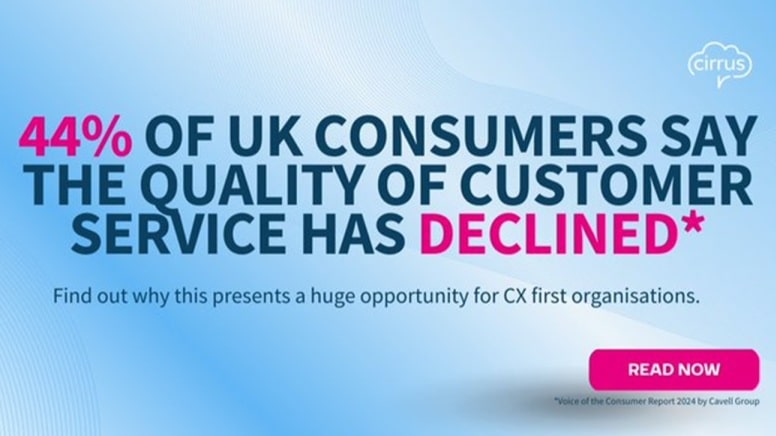Customer Satisfaction Score (CSAT) Scores are in Decline – Now is Your Time for your Contact Centre to Shine!

Ever wondered how businesses measure if you’re happy with their service? Well, when it comes to customer service, the go-to gauge for assessing your satisfaction is the Customer Satisfaction Score (CSAT). This straightforward metric offers instant insights into how well a business is meeting—or missing—the expectations of its customers. Whether it’s your favourite coffee shop, your internet provider, or the online store where you shop, CSAT scores are silently at work, shaping the customer experience.
It might be a bit shocking, but it’s true: CSAT scores are on a noticeable decline across various industries. According to the latest Voice of the Consumer Report by Cavell, a staggering 44% of consumers feel that the quality of customer service has worsened over the last three years. This isn’t just a minor hiccup—it’s a significant downturn that’s sounding alarm bells for businesses everywhere. The decline in CSAT scores is a clear signal that it’s time for companies to step up their game, and improve how they engage with customers to not only recover lost ground but also to take their service to new heights and build deeper customer loyalty.
Let’s take a look into what this important metric means and why it matters more than ever in today’s service-driven marketplace.
How is CSAT Calculated?
Simply put, after a service interaction, customers are asked to rate their satisfaction with the service on a typical scale, such as 1 to 5 or 1 to 10. These responses are then converted into a percentage of customers who responded with the top scores—usually the top two—indicating satisfaction. This percentage represents the CSAT score and gives businesses a quick snapshot of where they stand in their customers’ eyes at any given moment.
This method allows businesses to get a real-time pulse on customer feelings and quickly gauge the effectiveness of their customer service team. But remember, while CSAT is incredibly useful for snapping a quick picture of customer sentiment, it’s just one piece of the puzzle in understanding the full customer experience. Businesses that pay attention to these scores and dig deeper into the feedback can identify key areas for improvement and continue to refine their interactions to better meet customer needs.
Pinpointing the Decline
Insights from the Cavell report paint a concerning picture: 38% of consumer interactions do not meet expectations, contributing to a worrying scenario where nearly half (45%) of consumers choose to forgo resolving issues with products or services simply to avoid poor customer service experiences. This widespread dissatisfaction highlights the urgent need for businesses to rethink and innovate their customer engagement strategies, coverting basic service encounters into consistently positive, memorable experiences.
Embracing a Customer-First Approach
Amidst falling CSAT scores, a closer examination of customer preferences reveals significant trends: 52% of consumers favour email for routine communications, while a slightly higher percentage (54%) prefer telephone calls for urgent matters. Additionally, 18% are now opting for SMS for critical updates, signalling a shift towards more direct and immediate forms of communication. These preferences highlight the vital importance of aligning business communication strategies with customer expectations, emphasising the creation of services that are not only intuitive and responsive but also deeply personalised.
How to Turn it Around
In the face of declining CSAT scores, businesses are presented with a challenge—and a golden opportunity. It’s time to transform how we connect with customers and redefine the standards of service excellence. Here’s how companies can pivot and drive their CSAT scores back up:
1. Broaden Communication Channels
Given that 52% of consumers prefer email and 54% still rely on phone calls for urgent matters, businesses must ensure these channels are optimised for speed and efficiency. Adding SMS as a proactive communication tool can also be strategic, as 18% of consumers now appreciate text messages for quick updates. This requires not just opening more lines of communication but also refining them to meet customer preferences with precision.
2. Personalise Customer Interactions
Customers don’t just want solutions—they want to feel understood and valued. Personalising interactions by remembering past concerns, customising communications, and anticipating needs can dramatically improve customer satisfaction. Utilising data analytics to tailor the customer journey can help make each interaction feel more relevant and engaging.
3. Invest in Training and Development
The effectiveness of any customer service team hinges on their ability to handle inquiries empathetically and efficiently. Regular training sessions that focus on soft skills like communication, empathy, and problem-solving can equip customer service representatives to handle a range of situations with care and competence.
4. Leverage Technology Wisely
While only 5% of consumers find automated systems very effective, integrating technology doesn’t mean replacing the human touch—it means enhancing it. Intelligent automation and AI can handle routine inquiries and free up human agents to deal with complex issues, ensuring that customer service is both swift and satisfying.
5. Implement Real-Time Feedback Mechanisms
To keep a pulse on customer sentiment, real-time feedback tools can be incredibly useful. Quick surveys immediately after service interactions not only measure satisfaction but also signal to customers that their opinions are valued. This immediate loop of feedback can help catch dissatisfaction early and allow for quick corrections.
6. Focus on Employee Satisfaction
Happy employees mean happy customers. Ensuring that your team feels supported and valued can lead to more engaged and enthusiastic service. From competitive salaries to creating a positive work culture, investing in your team’s well-being can have a direct impact on the quality of their interactions with customers.
7. Set Clear and Transparent Policies
Confusion often leads to frustration. Clear, transparent policies about returns, warranties, and support can prevent misunderstandings and ensure that customers feel secure in their dealings with a business. When customers understand what to expect, their satisfaction levels are naturally higher.
A Tale of Success: Cats Protection’s
Cats Protection, the UK’s largest feline welfare charity, confronted severe challenges with long wait times driven by a surge in inquiries. By implementing a comprehensive omni-channel approach and integrating a conversational AI chatbot, they achieved dramatic improvements: missed calls were cut from 16% to just 7%, and they handled 33% more calls than the previous year. These enhancements enabled 24/7 self-service options, drastically reducing response times and significantly boosting customer satisfaction. This success story illustrates the profound impact of leveraging technology to meet and adapt to different demands of the customer base, resulting in more efficient service delivery and improved customer relationships.
Check out the in-depth case study here.
The Benefits of Getting It Right
Businesses focusing on refining their customer support can anticipate several advantages:
Improved Customer Retention: Satisfied customers are more likely to remain loyal, reducing churn and enhancing lifetime value.
Stronger Brand Reputation: High CSAT scores can improve a company’s standing, positioning it as a preferred choice for potential customers.
Greater Operational Efficiency: More efficient processes not only improve customer satisfaction but also enhance internal efficiency, allowing staff to focus on more strategic activities.
Conclusion: Your Time to Lead
The decline in CSAT scores highlights a clear call for change. Roughly half of the consumers still believe talking to a human is the fastest way to resolve issues, demonstrating that while technology is invaluable, the human element remains crucial. By focusing on customer-centric improvements and integrating responsive, personalised customer interactions, your business can not only meet but exceed customer expectations. This is your moment to innovate and set new standards in customer service. Let every interaction be a step toward building a loyal, satisfied customer base, ensuring that your business doesn’t just grow but thrives in today’s competitive landscape.
![]()
 Cirrus provides the premier solution to implement messaging and live chat support seamlessly across your organisation. With AI-powered automation, unified cross-channel conversation management, and comprehensive analytics, Cirrus enables businesses to deliver best-in-class messaging experiences that delight customers while driving operational efficiency.
Cirrus provides the premier solution to implement messaging and live chat support seamlessly across your organisation. With AI-powered automation, unified cross-channel conversation management, and comprehensive analytics, Cirrus enables businesses to deliver best-in-class messaging experiences that delight customers while driving operational efficiency.
Cirrus is at the forefront of the CCaaS industry, dedicated to improving customer service through innovative technology and a deep understanding of the human aspect of customer interactions. With a proven track record of success, Cirrus is trusted by major brands to enhance customer experiences.
For additional information on Cirrus view their Company Profile



